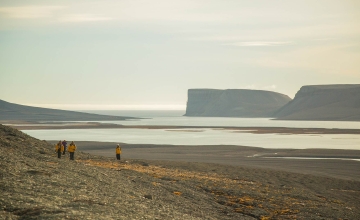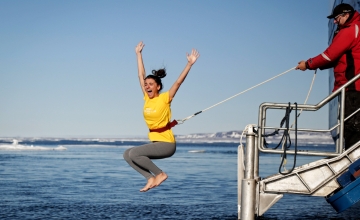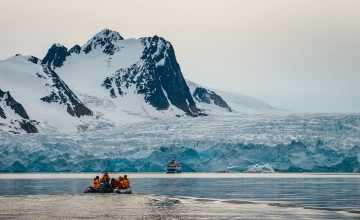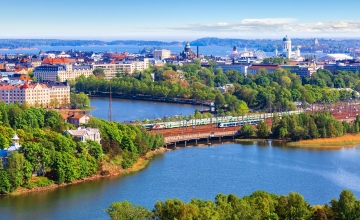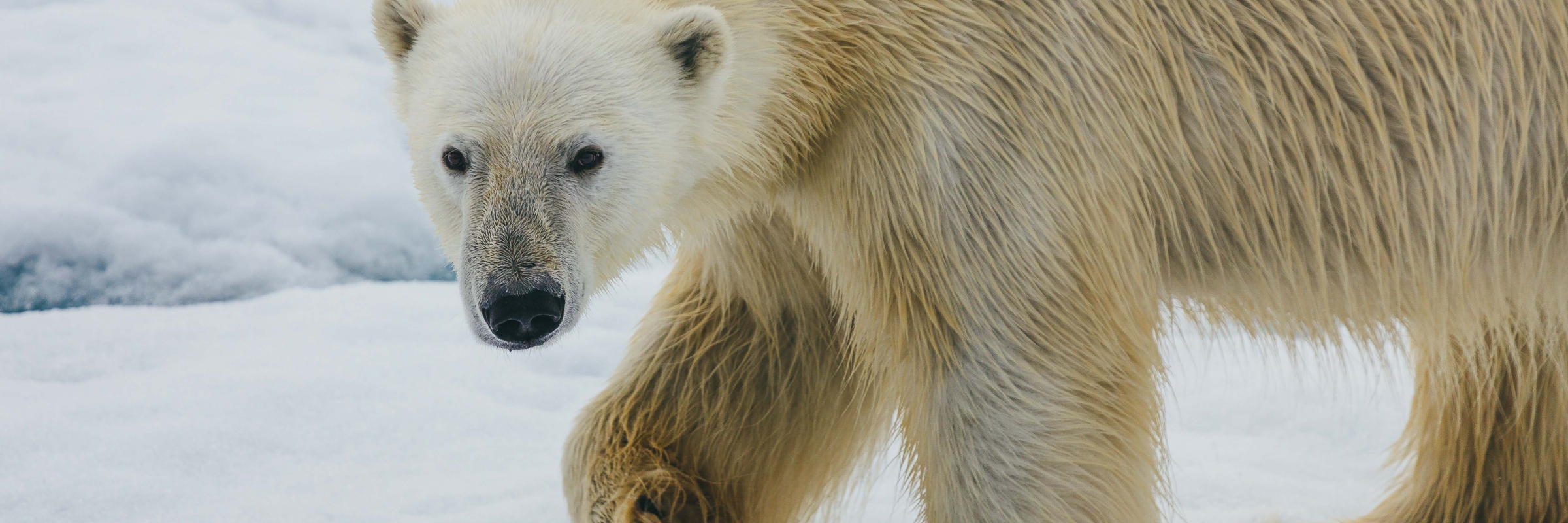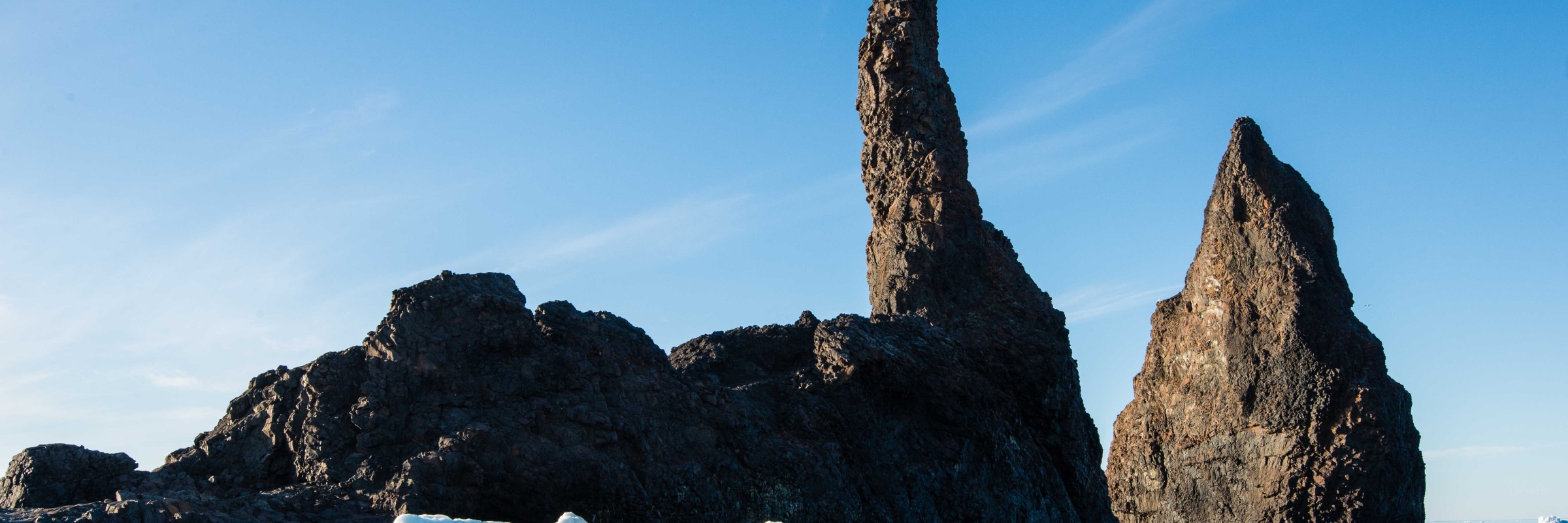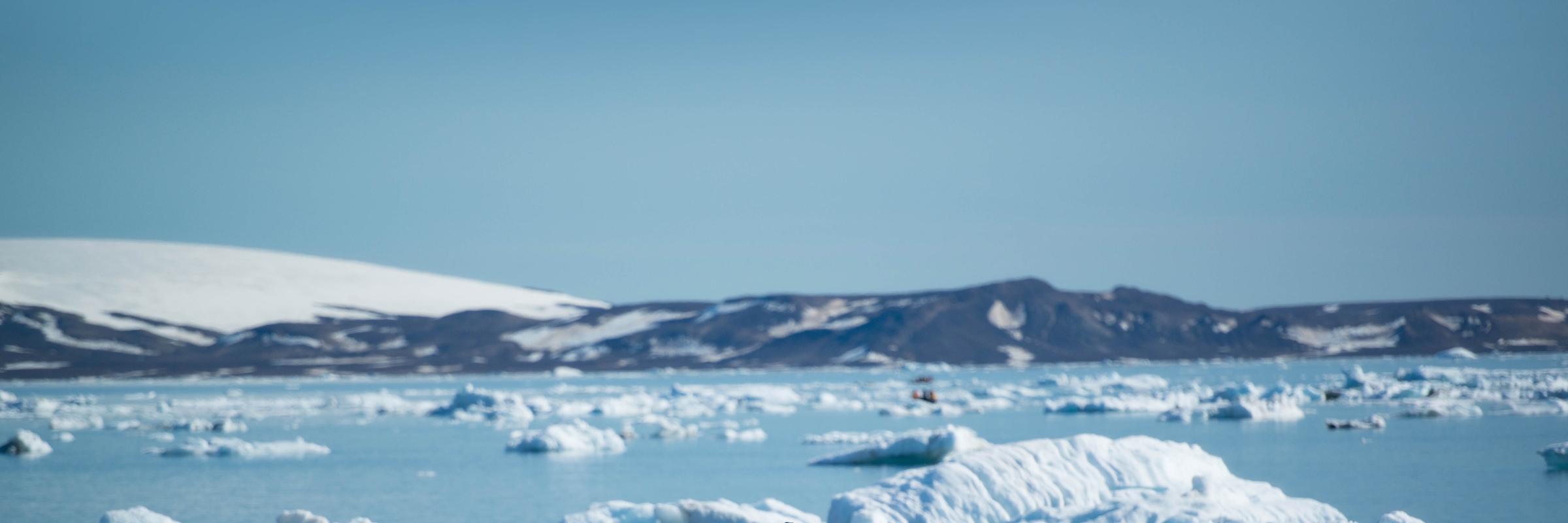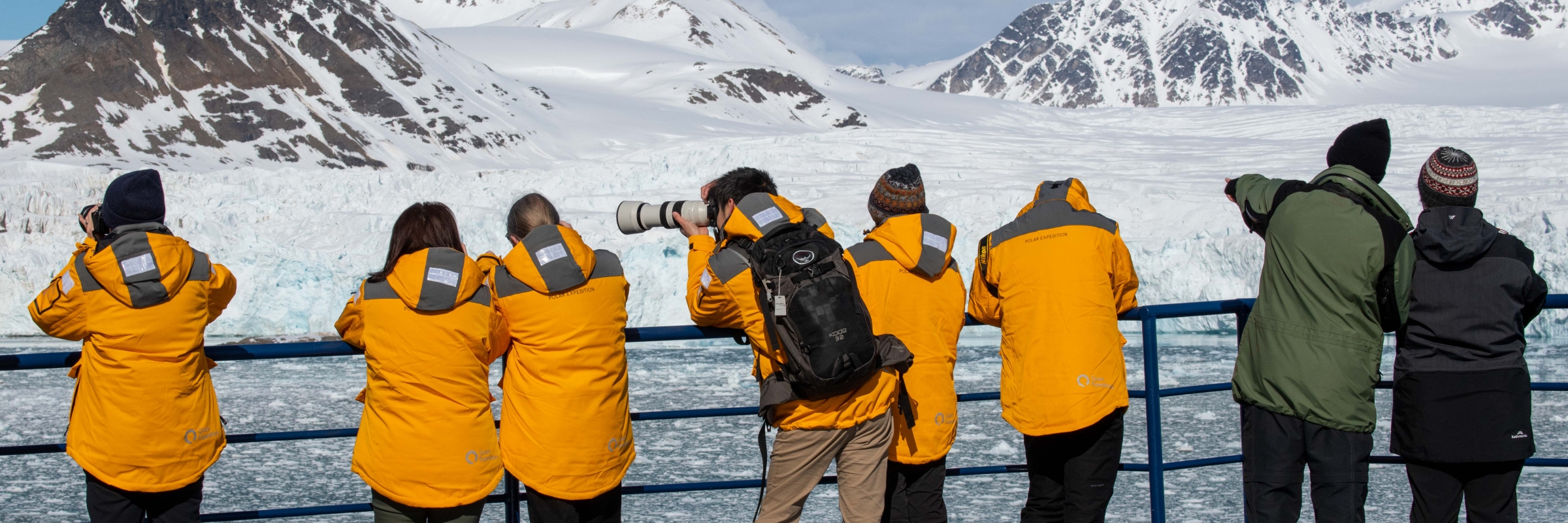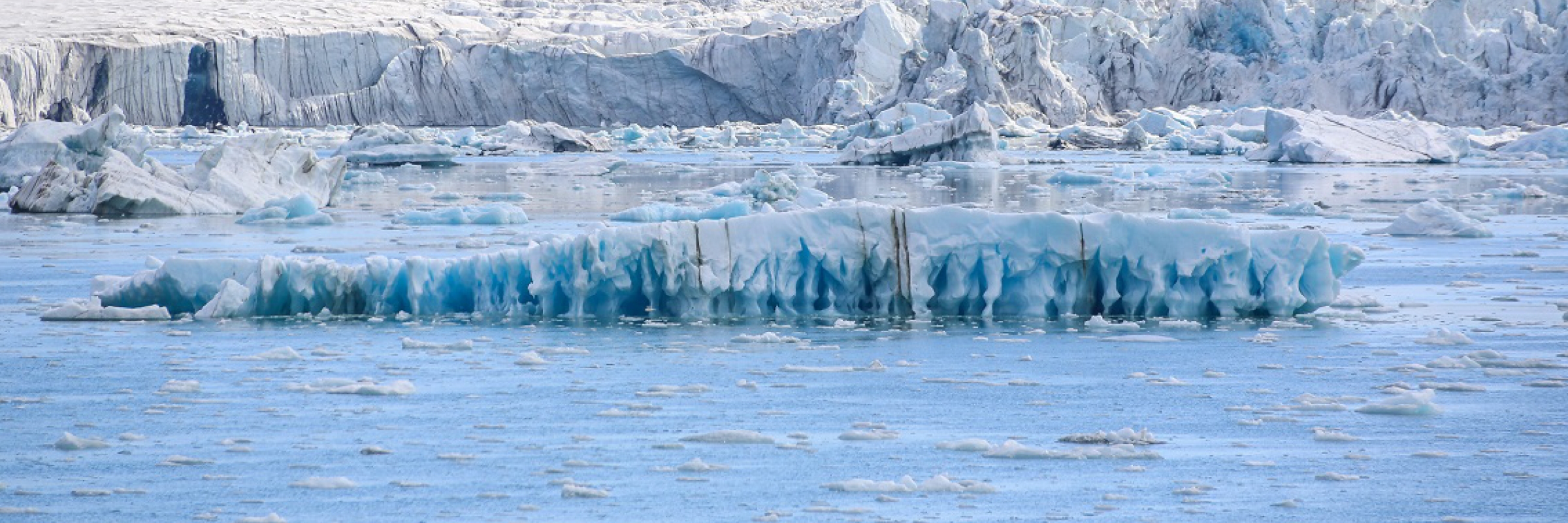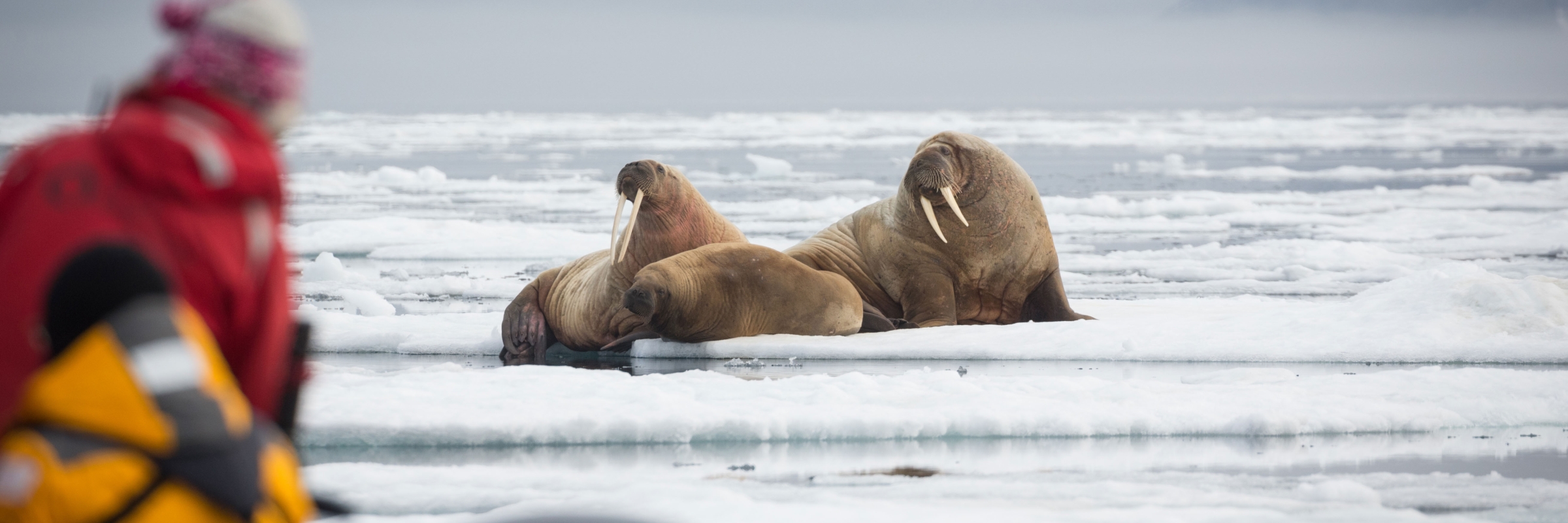Your Arctic adventure begins in Helsinki, renowned for its extraordinary architecture and intriguing mix of eastern and western influences. If you arrive early, explore the many museums, galleries and restaurants, relax at a Finnish sauna or wander the vibrant Design District before retiring at your included hotel.
Jewels of the Russian Arctic: Franz Josef Land and Novaya Zemlya
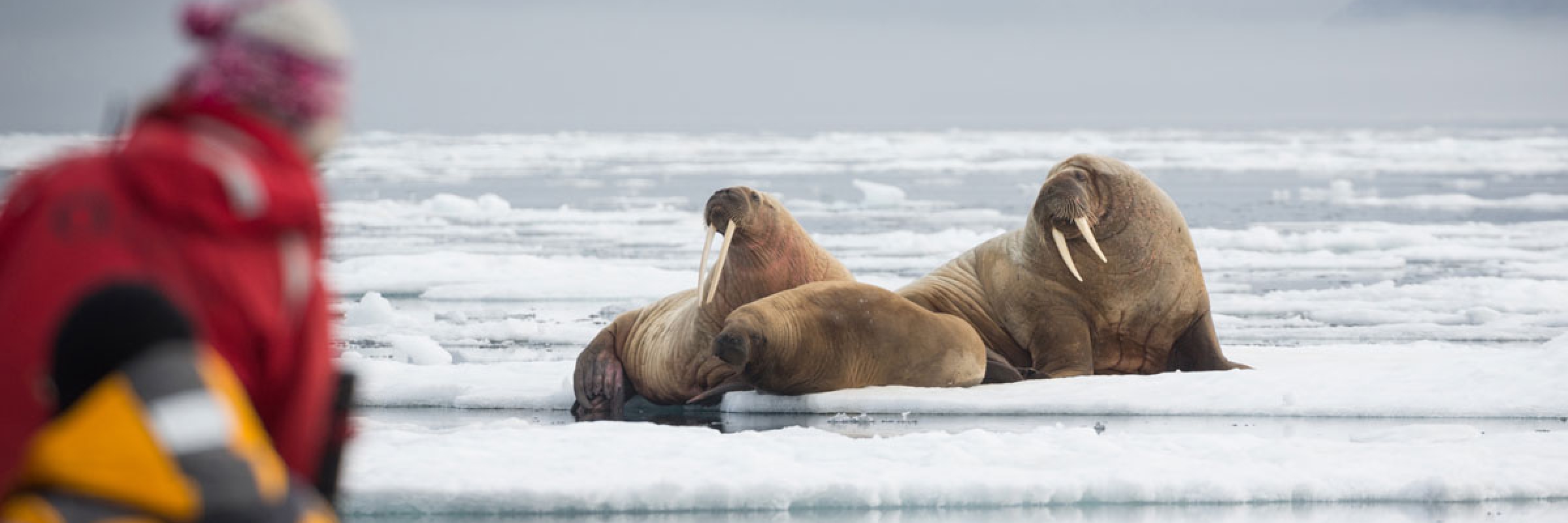
One of Earth’s least-explored frontiers and the newest destination to our portfolio, the sparsely populated Russian High Arctic is a place of isolated, rugged beauty that will leave you amazed. Few travelers have ever ventured into this near-uninhabited landscape. On Jewels of the Russian Arctic: Franz Josef Land and Novaya Zemlya, we follow the footsteps of early northern explorers to two of the most remote archipelagos on the planet, enabling guests to experience an in-depth exploration of seldom-visited regions in the stark and spectacular Russian Arctic.
From the ancient mountains of Novaya Zemlya to the wildlife sanctuary of Franz Josef Land, these secluded lands offer an exhilarating mix of unique sights and adventures. Marvel at ice-capped peaks soaring majestically out of the Arctic sea. Watch in hushed wonder at the unforgettable sight of a polar bear roaming its natural environment. Immerse yourself in a corner of our planet few humans ever to, with the operator that knows polar adventure better than anyone.
- Explore this rarely visited region of the Russian Arctic
- Encounter iconic arctic wildlife, such as polar bears, walrus and seabirds
- Explore glaciated Novaya Zemlya, where the earliest Arctic explorers overwintered
- Visit significant sites at Franz Josef Land and learn about the region’s storied history
行程
Day 1 — Arrive in Helsinki, Finland
Day 2 — Fly to Murmansk, Russia and Embark
After breakfast, we will transfer to the airport and board our private charter flight to Murmansk, Russia. Once aboard, get acquainted with the ship and crew and settle in for your voyage north.
Days 3 and 4 — At Sea
As we sail through the Barents Sea, your Expedition Team will prepare you for the adventures that await. Learn about the intriguing history and politics of the region, its fascinating wildlife, geology, ecology and climate, and the incredible sights you will soon explore. Staff will keep a lookout for seabirds, such as kittiwakes, skuas and fulmars soaring above your ship. Whale and seal sightings may also be possible in this biologically diverse sea.
Days 5 to 7 — Exploring Novaya Zemlya
The largest of the Eurasian Arctic archipelagoes, the rarely visited Novaya Zemlya (“New Land”) is the third-largest wilderness area in Europe. This long, narrow island actually consists of two main islands, Severny (northern) and Yuzhny (southern), separated by the imposing Matochkin Strait.
As we explore Novaya Zemlya, expect a new adventure every day. Each expedition will be unique, depending on the weather and ice, but a few landing sites we strive to visit include Inostrantseva Bay, the Oransky Islands, Cape Zhelaniya, Cape Spory Navalok and Russkaya Gavan.
Boasting one of the most picturesque glaciers in the entire archipelago, Inostrantseva Bay provides breathtaking panoramic views of pristine Arctic wilderness. If conditions allow, we may explore ashore, or Zodiac cruise along the face of the glacier, at a safe distance, possibly witnessing the wonders of calving ice. Encounters with Brünnich’s guillemots (thick-billed murres) are likely, owing to a small colony in the coastal cliffs.
To the northwest side of Severny Island are the Oransky Islands. Wildlife abounds here, with a variety of animal and plant life to be discovered; walrus have been sighted here on previous expeditions. Coming across a walrus haul-out is unforgettable. These giant pinnipeds of the Arctic create a raucous as each walrus vies for a choice spot of coastline. Encounters with whales and seabirds are possible, as well as polar bears, a genetically distinct subpopulation here.
A significant site in polar exploration, Novaya Zemlya also offers a number of opportunities for you to trace the routes of famous explorers and reflect on the region’s history.
Day 8 — At Sea
Bid farewell to Novaya Zemlya as we cruise farther north to Franz Josef Land. There are several activities to keep you engaged while at sea. Attend presentations by your Expedition Team, relax in our polar library or simply spend some time on deck, admiring the sea.
Days 9 to 12 — Exploring Franz Josef Land
This remote group of approximately 200 islands, many covered in ice, forms the most northerly archipelago in Eurasia and lies entirely within the Arctic Circle. A nature reserve, it is part of the Russian Arctic National Park. Weather and ice conditions will shape our exploration, but we hope to explore historical sites, remote seabird colonies and walrus haul-outs at some notable destinations—including Cape Flora, Cape Norway, Bell Island and Tikhaya Bukta. Polar bear encounters are also possible.
On Jackson Island, Cape Norway is where Norwegian explorers Fridtjof Nansen and Hjalmar Johansen wintered from 1895 to 1896. The conditions were astonishingly difficult, but they survived until the summer and continued their journey south. The remains of their small hut are still here today, along with a memorial marking the event.
Exploring Tikhaya Bukta (Calm Bay), the site of an abandoned weather station on Hooker Island, will feel like stepping back in time. There is plenty to discover as you wander the ruins, immersed in Russian polar history, and you may even be able to send a postcard from the post office!
The Stolichky and Appolonov Islands offer plentiful walrus encounters, as the lumbering giants can be found hauled out here. If ice and weather are in our favor, we’ll explore the area by Zodiac, at a safe distance, to view these pinnipeds of the Arctic in their natural habitat.
Days 13 and 14 — At Sea
As your Arctic expedition winds down you have a couple of days to sail through this wildlife-rich sea, where whales of various species are often seen. Take in a presentation, reminisce about your incredible journey with your shipmates, relax in the lounge while swapping stories and photos or enjoy the solitude of the sea. Expedition staff will be on hand to answer any remaining questions and spot wildlife.
Day 15 — Disembark in Murmansk and Fly to Helsinki, Finland
Returning to Russia’s most northerly city, you’ll have time to bid farewell to your Expedition Team and crew before catching our group charter flight back to Helsinki, where you will have one more night in this exquisite city.
Day 16 — Depart Helsinki
After breakfast, spend time exploring more of the Finnish capital or catch your homeward-bound flight.
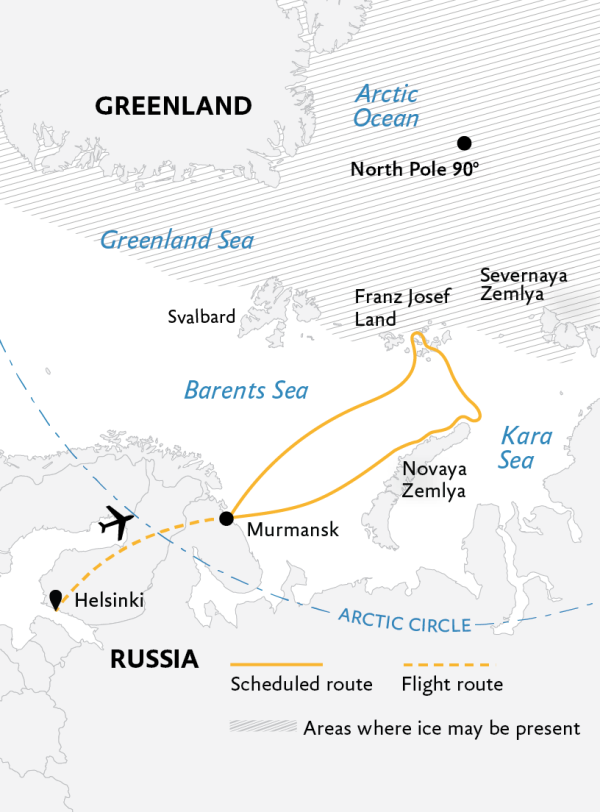
Day 1 — Arrive in Helsinki, Finland
Your Arctic adventure begins in Helsinki, renowned for its extraordinary architecture and intriguing mix of eastern and western influences. If you arrive early, explore the many museums, galleries and restaurants, relax at a Finnish sauna or wander the vibrant Design District before retiring at your included hotel.
Day 2 — Fly to Murmansk, Russia and Embark
After breakfast, we will transfer to the airport and board our private charter flight to Murmansk, Russia. Once aboard the Ocean Adventurer, get acquainted with the ship and crew and settle in for your voyage north.
Days 3 and 4 — Cruising
As we sail through the Barents Sea, your Expedition Team will prepare you for the adventures that await. Learn about the intriguing history of the region, its fascinating wildlife, geology, ecology and climate, and the incredible sights you will soon explore. Staff will keep a lookout for seabirds, such as kittiwakes, skuas and fulmars soaring above your ship. Whale and seal sightings are also probable in this biologically diverse sea.
Days 5 to 7 — Exploring Novaya Zemlya
The largest of the Eurasian Arctic archipelagoes, the rarely visited Novaya Zemlya (“New Land”) is the third-largest wilderness area in Europe. This long, narrow island actually consists of two main islands, Severny (northern) and Yuzhny (southern), separated by the imposing Matochkin Strait.
As we explore Novaya Zemlya, expect a new adventure every day. Each expedition will be unique, depending on the weather and ice, but a few landing sites we strive to visit include Inostrantseva Bay, the Oransky Islands, Cape Zhelaniya, Cape Spory Navalok and Russkaya Gavan.
Boasting one of the most picturesque glaciers in the entire archipelago, Inostrantseva Bay provides breathtaking panoramic views of pristine Arctic wilderness. If conditions allow, we may explore ashore, or Zodiac cruise along the face of the glacier, at a safe distance, possibly witnessing the wonders of calving ice. Encounters with Brünnich’s guillemots (thick-billed murres) are likely, owing to a small colony in the coastal cliffs.
On the northern side of Severny Island are the Oransky Islands. Wildlife abounds here, with a variety of animal and plant life to be discovered; walrus have been sighted here on previous expeditions. Coming across a walrus haul-out is unforgettable. These giant pinnipeds of the Arctic create a raucous chorus as each walrus vies for a choice spot of shore. Encounters with whales and seabirds are possible, as well as polar bears, a genetically distinct subpopulation here.
A significant site in polar exploration, Novaya Zemlya also offers a number of opportunities for you to trace the routes of famous explorers and reflect on the region’s history.
Day 8 — Cruising
Bid farewell to Novaya Zemlya as we cruise farther north to Franz Josef Land. There are several activities to keep you engaged while at sea. Attend presentations by your Expedition Team, relax in our polar library or simply spend some time on deck, admiring the sea and watching for wildlife.
Days 9 to 12 — Exploring Franz Josef Land
This remote group of approximately 200 islands, many covered in ice, forms the most northerly archipelago in Eurasia and lies entirely beyond the 80th north latitude, well within the Arctic Circle. A nature reserve, it is part of the Russian Arctic National Park. Weather and ice conditions will shape our exploration, but we hope to explore historical sites, remote seabird colonies and walrus haul-outs at some notable destinations— including Cape Flora, Cape Norway, Bell Island and Tikhaya Bukta. Polar bear encounters are also possible.
On Jackson Island, Cape Norway is where Norwegian explorers Fridtjof Nansen and Hjalmar Johansen overwintered from 1895 to 1896. The conditions were astonishingly difficult, but they survived until the summer and continued their journey south. The remains of their small hut are still here today, along with a memorial marking the event.
Exploring Tikhaya Bukta (Calm Bay), the site of an abandoned weather station on Hooker Island, will feel like stepping back in time. There is plenty to discover as you wander the ruins, replete with Russian polar history, and you may even be able to send a postcard from the post office!
The Stolichky and Appolonov Islands offer plentiful walrus encounters, as the lumbering giants can be found hauled out here. If ice and weather are in our favor, we’ll explore the area by Zodiac, at a safe distance, to view these pinnipeds of the Arctic in their natural habitat.
Days 13 and 14 — Cruising
As your Arctic expedition winds down you have a couple of days to sail through this wildlife-rich sea, where whales of various species are often seen. Take in a presentation, reminisce about your incredible journey with your shipmates, relax in the lounge while swapping stories and photos or enjoy the solitude of the sea. Expedition staff will be on hand to answer any remaining questions and spot wildlife.
Day 15 — Disembark in Murmansk and Fly to Helsinki, Finland
Returning to Russia’s most northerly city, you’ll have time to bid farewell to your Expedition Team and crew before catching our group charter flight back to Helsinki, where you will have one more night in this exquisite city.
Day 16 — Depart Helsinki
After breakfast, spend time exploring more of the Finnish capital or catch your homeward-bound flight.

